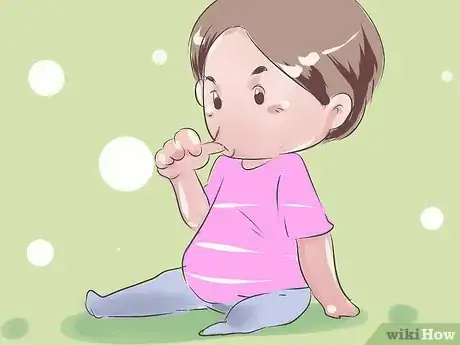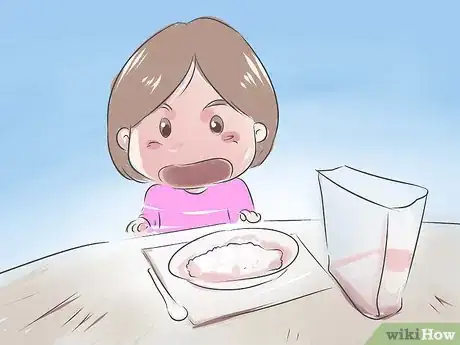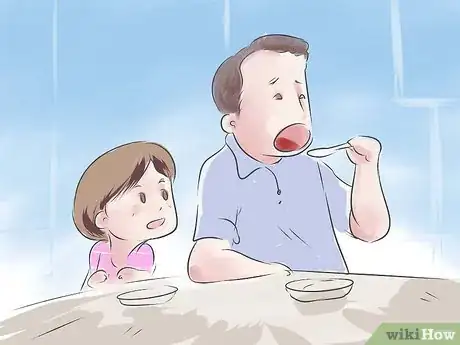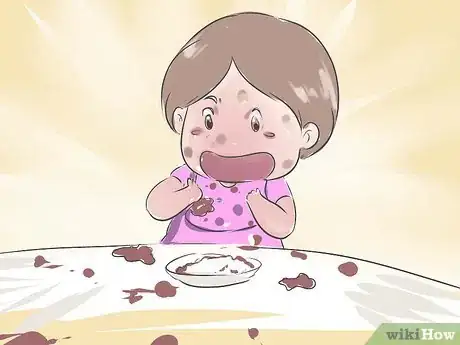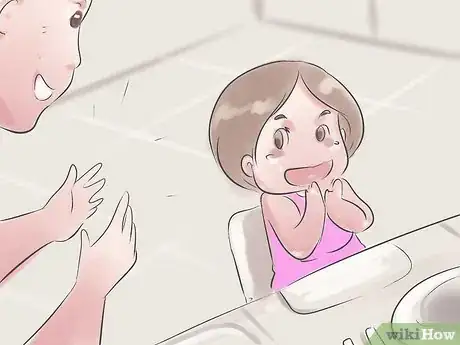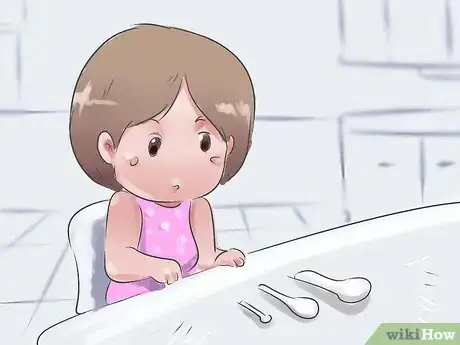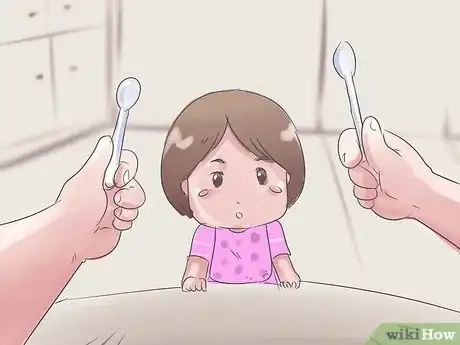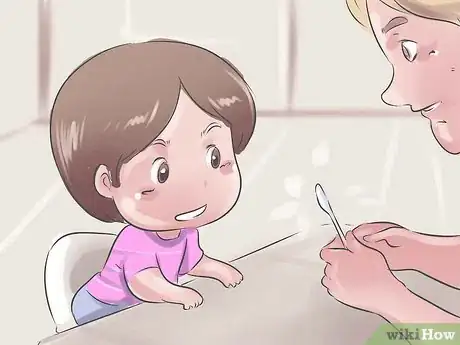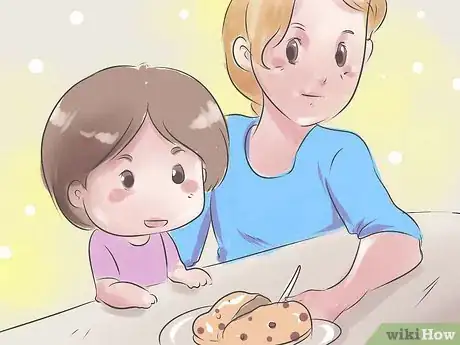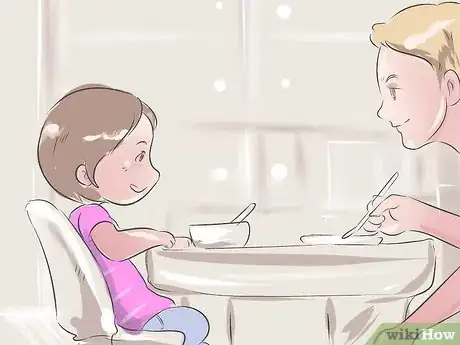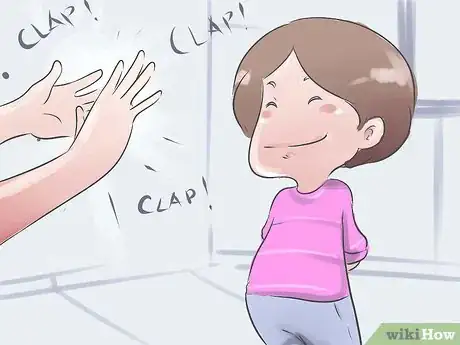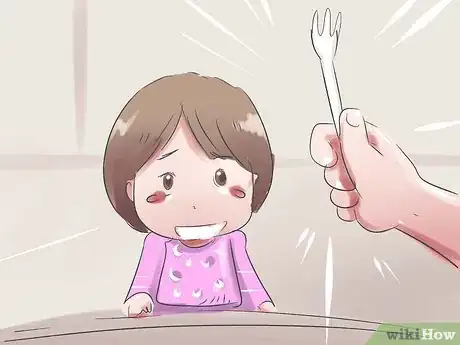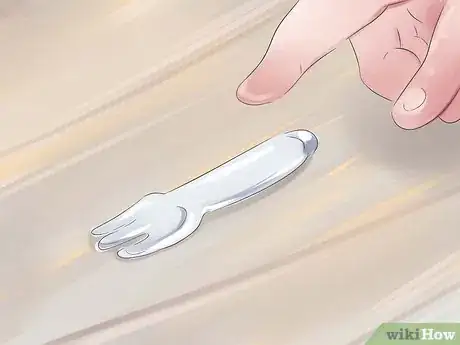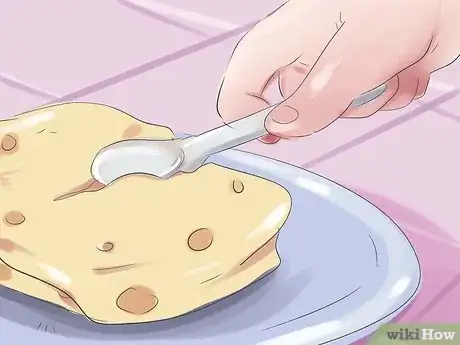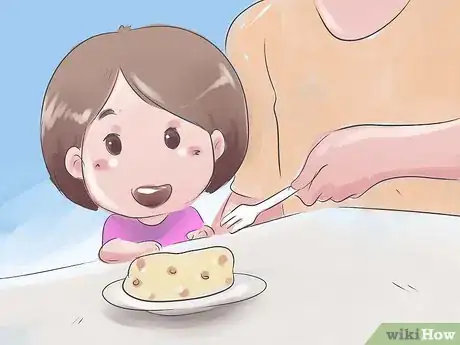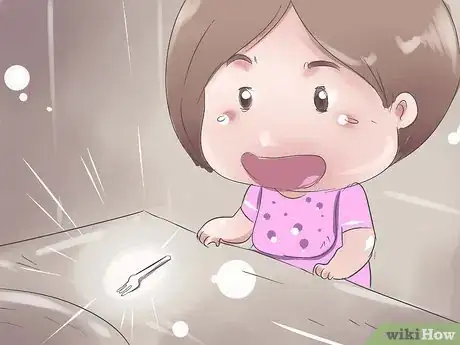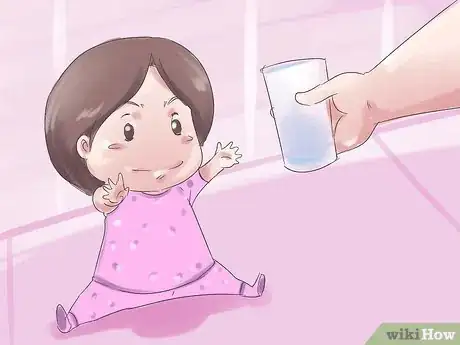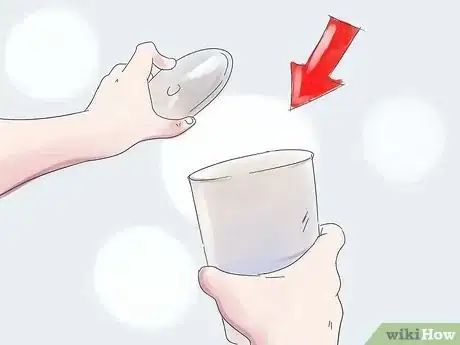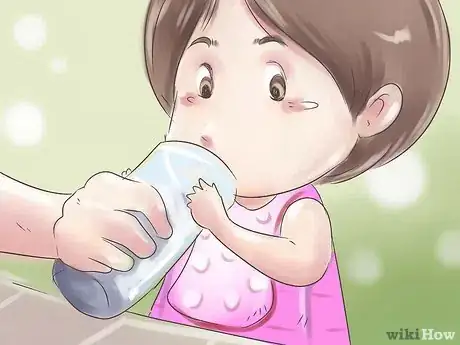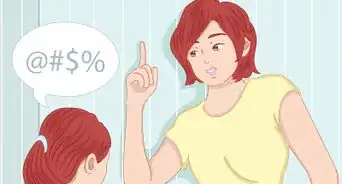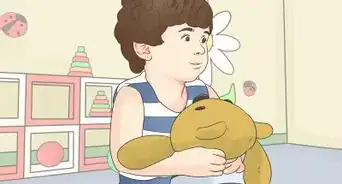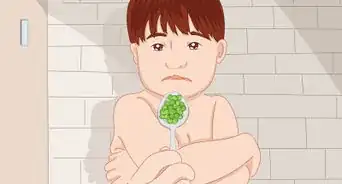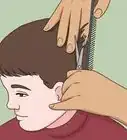X
wikiHow is a “wiki,” similar to Wikipedia, which means that many of our articles are co-written by multiple authors. To create this article, volunteer authors worked to edit and improve it over time.
There are 7 references cited in this article, which can be found at the bottom of the page.
This article has been viewed 73,152 times.
Learn more...
Babies eat instinctively, suckling at the breast or bottle. As they grow, they consume a much wider variety of foods, and as toddlers, they will want to eat them independently. Self-feeding takes some skill, however. You can play an important role in helping your toddler learn.
Steps
Part 1
Part 1 of 4:
Helping Your Toddler Eat Finger Foods
-
1Pay attention to your child’s desire to self-feed. Eating with the fingers is the first way that children learn to feed themselves, and you should watch for signs that you son or daughter is ready to try. This may actually begin well before the toddler period, at around eight or nine months of age. You may notice that your older baby will try to grab food (or other items!), at first with the whole hand and then, later on, with the fingers. These are signs that he or she is ready to start learning to eat independently.[1]
- The “pincer grasp” (the ability to grab small items with the thumb and forefinger) is especially crucial for effective self-feeding. Most babies develop this skill between about seven and eleven months of age.
-
2Offer your child safe foods to eat with his or her fingers. Start by giving your older baby or younger toddler bite-sized pieces of foods that are easy to chew and swallow. At first, stick to foods that dissolve easily in the mouth; by the toddler years, you can start offering many more foods. Some suggestions include:[2]
- low-sugar cereals, especially o-shaped and puffed varieties
- small pieces of ripe, soft fruits like bananas, mangos, peaches, or watermelon
- small pieces of soft, cooked vegetables like carrots, peas, or sweet potatoes
- cubed tofu
- cooked pasta
- small pieces of bread, bagels, or English muffins
- small bites of cheese
Advertisement -
3Practice with your child. Mealtimes are a chance to interact and help your child learn, so do not simply place food in front of your toddler and walk away. Sit with your child, talk about the new foods, and hold up individual bites to encourage the pincer grasp. Take your child’s hand in yours and demonstrate.
-
4Watch for choking. Always supervise your child when he or she is learning to eat finger foods. You can minimize the risk of choking by keeping the bites small (but not so small that he or she might swallow without chewing at all).
-
5Prepare for a mess. Babies and toddlers are very messy when they learn to eat. Use bibs, and try to minimize damage by removing rugs or placing a protective cover underneath your child’s high chair.[3]
-
6Praise your child’s efforts. Make sure your child knows that self-feeding is a good thing and that he or she has made you proud.
Advertisement
Part 2
Part 2 of 4:
Teaching Your Toddler to Eat with a Spoon
-
1Watch for signs that your child is ready. When your older baby or younger toddler can eat finger foods and has started to grab the spoon from you during meals, he or she is probably ready to learn to eat independently with a spoon.
-
2Choose the right spoon. Larger spoons will be too big for a toddler’s mouth; you want something teaspoon-sized. Consider purchasing special baby spoons, which are lighter, rounded at the top, and usually made of plastic.[4]
-
3Start with two spoons. To begin, use two spoons: one for you and one for your child. You can feed your child as usual, and he or she can also begin trying out the spoon.
- Don’t worry if, at first, your child uses the spoon primarily to bang on the plate or high chair tray and dribble food around. Self-feeding takes time; he or she will figure it out.
-
4Teach your child how to use a spoon. Show your toddler how to hold a spoon, and then help by placing your hand over his or her hand to demonstrate. Direct the spoon slowly into your toddler’s mouth.[5]
- As your toddler learns, you can also start using two bowls. You can feed your child from one; he or she can use the other, which should just have a small amount of food in it.
-
5Pick foods strategically. Start with thicker, denser foods; these will stay on the spoon, whereas more liquid foods will drip away before your child manages to get the spoon to his or her mouth. Yogurt, cottage cheese, and pudding work well. As your child progresses, move on to thinner purees and soups.
-
6Set an example. Eat when your child eats; family meals are important for teaching self-feeding skills, communication, and manners.[6]
-
7Praise your child’s efforts. Let your toddler know you are proud of his or her growing independence.
Advertisement
Part 3
Part 3 of 4:
Teaching Your Toddler to Eat with a Fork
-
1Wait until your toddler is ready. In general, it’s best to wait until your son or daughter has developed a strong pincer grasp and can use the spoon relatively well. At that point, you can introduce the fork. Most children are ready by fifteen to eighteen months or so.
-
2Choose the right fork. To begin, select a fork made for young children, with rounded tips and a lighter weight. These are both safer and easier for a toddler to use successfully.
-
3Start with foods that are easy to pierce. Offer larger pieces of food that are fairly easy to pierce and hold with a fork: cubes of cheese work well, as do some kinds of cooked vegetables, meats, and pastas. Avoid foods that are too small, crumbly, or slippery. You don’t want to frustrate your child unnecessarily.
-
4Help your child use the fork. In the beginning, you may need to take your child’s hand and demonstrate how to pierce and pick up a piece of food.
-
5Encourage eating with the fork. Once your toddler is two or so, it’s fine to encourage fork-eating, but don’t worry if your child continues to prefer using his or her fingers. You can wait until the preschool years to start pushing harder for better table manners.
-
6Praise your child’s efforts. Again, let your toddler know that you are impressed with his or her new skills.[7]
Advertisement
Part 4
Part 4 of 4:
Helping Your Toddler Drink Independently
-
1Let babies drink independently from a bottle. Before the toddler years, you can let an older baby hold a bottle and drink on his or her own. This will prepare your child for using a cup later on.
-
2Introduce a cup with a lid. Most children can start to drink from a cup by about a year of age. Make life easier for both of you by starting with a lidded cup made for toddlers. This will minimize spills and mimic the “feel” of a bottle.
- Understand that even with a lidded cup, your child will probably make a mess. That’s okay; it’s part of the learning process.
-
3Remove the lid. Once your child has mastered drinking from a lidded cup, you can remove the lid. Don’t fill the cup more than halfway – better to refill multiple times than to have your child dump a completely full cup all over the place.[8]
-
4Help your toddler as necessary. You can ease your child into drinking from a cup by holding the cup steady during his or her first attempts, placing your hands over your toddler’s hands so that he or she gets the sense of what drinking from a cup should feel like.[9]
Advertisement
Community Q&A
-
QuestionI cant get my toddler to eat anyting not pureed. What can I do?
 Community AnswerStart slow and feed her very soft foods.
Community AnswerStart slow and feed her very soft foods. -
QuestionHow do I travel by airplane with a 17-month-old child?
 Community AnswerIf you're traveling with a 17 month-year-old child, the key is entertainment. If you want a smooth flight, make sure you're always prepared with books, snacks, and toys. Pack items that aren't in pieces and that are airplane safe such as a stuffed animal or a medium-size book of your child's choice.
Community AnswerIf you're traveling with a 17 month-year-old child, the key is entertainment. If you want a smooth flight, make sure you're always prepared with books, snacks, and toys. Pack items that aren't in pieces and that are airplane safe such as a stuffed animal or a medium-size book of your child's choice. -
QuestionMy 5 years girl does not eat by herself and isn't interested in any food. How will I develop her interest in food and help her eat by herself? She keeps food in her mouth for hours, and won’t bite and swallow.
 Community AnswerThis is an issue that many mothers face. When you feed your daughter something, try making it look different so she could go for a bite or two. This actually did work for my 4 yr old too. Try arranging your food so that it looks like a smiley face. Another idea is to give her something to dip her food in, as many toddlers love to dip.
Community AnswerThis is an issue that many mothers face. When you feed your daughter something, try making it look different so she could go for a bite or two. This actually did work for my 4 yr old too. Try arranging your food so that it looks like a smiley face. Another idea is to give her something to dip her food in, as many toddlers love to dip.
Advertisement
References
- ↑ https://yourkidstable.com/teach-your-child-to-feed-themselves/
- ↑ https://www.babycenter.com/finger-foods
- ↑ https://yourkidstable.com/why-you-should-let-your-baby-or-toddler/
- ↑ https://www.educatall.com/page/1294/How-to-teach-a-child-to-eat-independently.html
- ↑ https://www.education.com/magazine/article/toddler-eating-independently/
- ↑ https://www.educatall.com/page/1294/How-to-teach-a-child-to-eat-independently.html
- ↑ https://www.babycenter.com/0_toddler-milestone-self-care_6503.bc
- ↑ https://raisingchildren.net.au/toddlers/nutrition-fitness/family-meals/learning-to-feed-themselves
- ↑ https://raisingchildren.net.au/toddlers/nutrition-fitness/family-meals/learning-to-feed-themselves
About This Article
Advertisement
